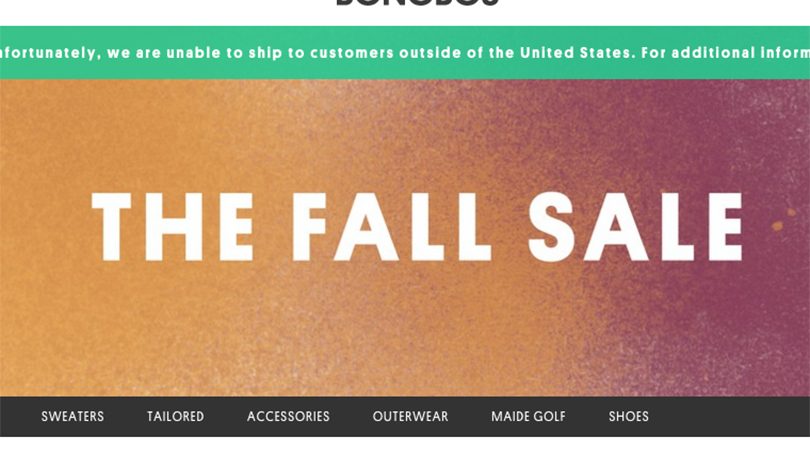Offline opportunities for Bonobos

One discovery altered the worldview of Andy Dunn, founder and chairman of fashion brand, Bonobos, and radically changed the evolution of his business model.
Shoppers don’t need to walk out of a shop with the product they just purchased.
Dunn came to this realisation after the pureplay online fashion retailer trialled in-person customer service by setting up two fitting rooms in the lobby of their office. Within 90 days, $1 million of the company’s $20 million revenue was being generated in the lobby.
“E-commerce has separated the moment of the transaction from the moment of fulfilment of the goods,” Dunn said in his keynote speech at the Online Retailer Conference & eCommerce Expo at Sydney’s Hordern Pavilion this week.
Bonobos Inc is the parent company of e-commerce-driven apparel brands Bonobos, Maide by Bonobos, and AYR. The company was founded in 2007 with namesake menswear brand, Bonobos, with the mission of selling better-fitting pants to men online.
Specifically, the aim was to cure the male population of “khaki diaper butt”, a bulky excess of fabric in the seat of men’s pants.
“Our aspiration was that the challenge of making money in e-commerce is you are selling other people’s stuff where the margin is thin, then you are doing a lot of free shipping, easy returns and all this marketing,” he said in Sydney on Wednesday July 22. “It makes it really hard to actually generate profits.”
In the early days, the goal was to, “generate profits by owning the brand – by owning that gross margin”.
Shirt hurt
After building a successful online business, Bonobos was driven to testing the fitting room concept by the lacklustre reception to a new category launch. After making its name in pants, the brand decided to branch out into shirts.
“We got our shirts business live, we were really excited and, we discovered our customer did not care,” Dunn said.
After a tense board meeting to respond to the criticism, “what are you doing? It’s not working”, Dunn pushed for developing an in-person try-on model.
To backtrack, the company had decided to launch a line of shirts after much debate. Undecided, they turned to their customers, and asked them, “Why do you buy Bonobos?”. After analysing the results, they took away three key things that enticed shoppers to Bonobos – fit, service and fun.
“Bringing fit, service and fun in menswear became our guideposts,” he said. “We realised that if we are going to solve the fit issue with great service and a little bit of fun, it can’t just be pants.”
They discovered a comparable complaint about ill-fitting shirts, referred to as “billowing muffin top” – when excess fabric billows out when shirts are tucked into pants.
The brand designed a standard shirt that takes out a lot of the fabric, a true slim, and a tailored with fit darts in the back, in 20 different sizes.
“The same kind of thing that would be impossible to serve in the traditional retail model because you just couldn’t stock all that inventory,” Dunn said.
A little bit of genius
From this sprung the idea to let consumers try on clothes for fit, without leaving the store with bulky bags of product.
The idea was to redesign a store, with the same 1:1 customer service delivered at, for example, the Apple Genius Bar, and to, “put into the interaction great service, and take out of it this idea that it’s a good thing to walk out with bags of clothes.”
To Dunn’s surprise, this worked like a charm.
“What are you going to do? Go home and tear off your clothes and put it on?” he asked Online
Retailer Conference attendees in his keynote. “Generally that’s not the consumer behaviour, and yet the whole industry has educated us that instant gratification is critical. I think if you are hungry or buying a coffee or food, then that’s true. I’m not sure that in clothing it’s true.”
Bonobos now has 19 ‘guide stores’, as they are called, including a flagship in New York City. Dunn said the stores took the brand’s marketing expenses from an all-time maximum of 25 per cent, to under 10 per cent.
And, as of May 2015, the business actually made money, which Dunn said was a, “big coup for an eCommerce brand”.
Bonobos’ change in thinking around consumer behaviour could lead to changes in thinking about inventory and order distribution management.Whether it will work in Australia, or even for women shoppers for that matter is yet to be proven.
Bonobos also has a partnership with US fashion retailer, Nordstrom. Touching on the Bonobos-Nordstrom relationship, Dunn said that a lot of vertical brands treat wholesale as the enemy, but he prefers to think of the Nordstrom partnership as, “great marketing”.
Despite the successful forays into bricks and mortar retail, Dunn said e-commerce remains the core engine of the Bonobos business model.
“It is the fulfilment mechanism,” Dunn said of e-commerce. “It’s the way that we tell the story and our number one source of repeat customer behaviour and number one place to bring in new customers.”
This story first appeared in Inside Retail Weekly, issue 2055. To subscribe, click here.
Comment Manually
You must be logged in to post a comment.

No comments